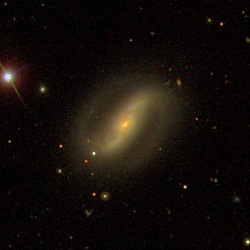NGC 4332
| NGC4332 | |
|---|---|
 SDSSimage of NGC 4332. | |
| Observation data (J2000epoch) | |
| Constellation | Draco |
| Right ascension | 12h22m46.7s[1] |
| Declination | 65° 50′ 38″[1] |
| Redshift | 0.009228[1] |
| Heliocentric radial velocity | 2766 km/s[1] |
| Distance | 128Mly(39.2Mpc)[1] |
| Grouporcluster | NGC 4256 Group(NGC 4210 Subgroup) |
| Apparent magnitude(V) | 13.3[1] |
| Characteristics | |
| Type | SB(s)a[1] |
| Size | ~102,200ly(31.34kpc) (estimated)[1] |
| Apparent size(V) | 1.04 x 0.70[1] |
| Other designations | |
| UGC 07453, PGC 040133, MCG +11-15-048,CGCG 315-033[1] | |
NGC 4332is abarred spiral galaxy[2]and astarburst galaxy[3]located 128 millionlight-yearsaway[2]in theconstellationDraco.The galaxy was discovered by astronomerWilliam Herschelon March 20, 1790.[4]NGC 4332 is host to asupermassive black holewith an estimated mass of 9.5×107solar masses.[5]
NGC 4332 is a member of theNGC 4256 Group,[6][7][8]and is located in a subgroup surounding the galaxyNGC 4210.[9]The NGC 4256 Group is located within theCanes Venatici-Camelopardalis Cloud,[6]which lies in the First Upper Plane of theVirgo Supercluster.[7]
SN 2009an
[edit]NGC 4332 has hosted one supernova,[10]aType Ia supernovadesignated as SN 2009an that had anapparent magnitudeof 15.4. The supernova was discovered by Giancarlo Cortini and Stefano Antonellini with a 35-cm telescope at theMonte Maggiore ObservatoryinPredappio, Italyon February 27, 2009. It was independently discovered by Petri Kehusmaa ofHyvinkaa, Finlandand Mikko Paivinen ofRajamaki, Finlandon February 28, 2009 using a 28-cm Schmidt-Cassegrain reflector.[11]
SN 2009an had absolute magntude of -18.841 ± 5 in the blue part of the spectrum. This makes it dimmer than a normalType Ia supernova.Also, SN 2009an had alight curvethat declined a lot faster than a normalType Ia supernova.Additionally, thebolometric luminosityis estimated at 42.89 erg/s, implying that about 0.41solar massesof were synthesized in the supernova. However, to account for additionalfluxlost from UV and NIR light bands, the estimate for the amount ofnickel-56thought to have formed in the supernova increases to 0.50solar masses.Lastly,spectroscopic datashow that SN 2009an has high-velocity features which are observed in thecalcium tripletduring its pre-maximum and early post-maximum phases. However, the post-maximum spectral evolution resembles a normal Type Ia supernovae, with SN 2009an containing broad Si II 6355 Å lines and Si II 5972 Å lines that are stronger than a normal Type Ia supernova.
These properties make Sn 2009an most similar to another Type Ia supernova known as SN 2004eo. It is thought that supernovae like SN 2009an and SN 2004eo form from the explosion of awhite dwarfwith lower amounts of kinetic energy than a normal Type Ia supernova and produce more stable elements from theIron-Groupof the periodic table such asiron,nickeland others. These types ofType Ia supernovae account for only 15% of all observed Type Ia supernovae known as non-standard or transitional Type Ia events.[12]
See also
[edit]- List of NGC objects (4001–5000)
- NGC 4513-Ring galaxy in the NGC 4256 Group
References
[edit]- ^abcdefghij"NASA/IPAC Extragalactic Database".Results for NGC 4332.Retrieved2024-06-23.
- ^ab"Your NED Search Results".ned.ipac.caltech.edu.Retrieved2024-06-24.
- ^Koulouridis, Elias; Chavushyan, Vahram; Plionis, Manolis; Krongold, Yair; Dultzin-Hacyan, Deborah (2006-11-01)."A Three-dimensional Study of the Local Environment of Bright IRAS Galaxies: The Active Galactic Nucleus-Starburst Connection".The Astrophysical Journal.651:93–100.doi:10.1086/507070.ISSN0004-637X.
- ^"New General Catalog Objects: NGC 4300 - 4349".cseligman.com.Retrieved2024-06-24.
- ^Arzoumanian, Zaven; Baker, Paul T.; Brazier, Adam; Brook, Paul R.; Burke-Spolaor, Sarah; Becsy, Bence; Charisi, Maria; Chatterjee, Shami; Cordes, James M.; Cornish, Neil J.; Crawford, Fronefield; Cromartie, H. Thankful; Decesar, Megan E.; Demorest, Paul B.; Dolch, Timothy (2021-06-01)."The NANOGrav 11 yr Data Set: Limits on Supermassive Black Hole Binaries in Galaxies within 500 Mpc".The Astrophysical Journal.914:121.doi:10.3847/1538-4357/abfcd3.ISSN0004-637X.
- ^abNolthenius, Richard (1993-03-01)."A Revised Catalog of CfA1 Galaxy Groups in the Virgo/Great Attractor Flow Field".The Astrophysical Journal Supplement Series.85:1.doi:10.1086/191753.ISSN0067-0049.
- ^abFouque, P.; Gourgoulhon, E.; Chamaraux, P.; Paturel, G. (1992-05-01)."Groups of galaxies within 80 Mpc. II. The catalogue of groups and group members".Astronomy and Astrophysics Supplement Series.93:211–233.ISSN0365-0138.
- ^Garcia, A. M. (1993-07-01)."General study of group membership. II. Determination of nearby groups".Astronomy and Astrophysics Supplement Series.100:47–90.ISSN0365-0138.
- ^Giuricin, Giuliano; Marinoni, Christian; Ceriani, Lorenzo; Pisani, Armando (2000-11-01)."Nearby Optical Galaxies: Selection of the Sample and Identification of Groups".The Astrophysical Journal.543:178–194.doi:10.1086/317070.ISSN0004-637X.
- ^"List of supernovae sorted by host name".Bright Supernova - Archives.Retrieved2024-06-24.
- ^Green, Daniel W. E. (2009-02-28)."SUPERNOVA 2009an IN NGC 4332".Central Bureau for Astronomical Telegrams.International Astronomical Union.Archivedfrom the original on 2012-10-06.Retrieved2024-06-24.
- ^Sahu, D. K.; Anupama, G. C.; Anto, P. (2013-04-01)."Photometric and spectroscopic evolution of supernova SN 2009an: another case of a transitional Type Ia event".Monthly Notices of the Royal Astronomical Society.430:869–887.doi:10.1093/mnras/sts609.ISSN0035-8711.
External links
[edit]- NGC 4332 onWikiSky:DSS2,SDSS,GALEX,IRAS,Hydrogen α,X-Ray,Astrophoto,Sky Map,Articles and images
